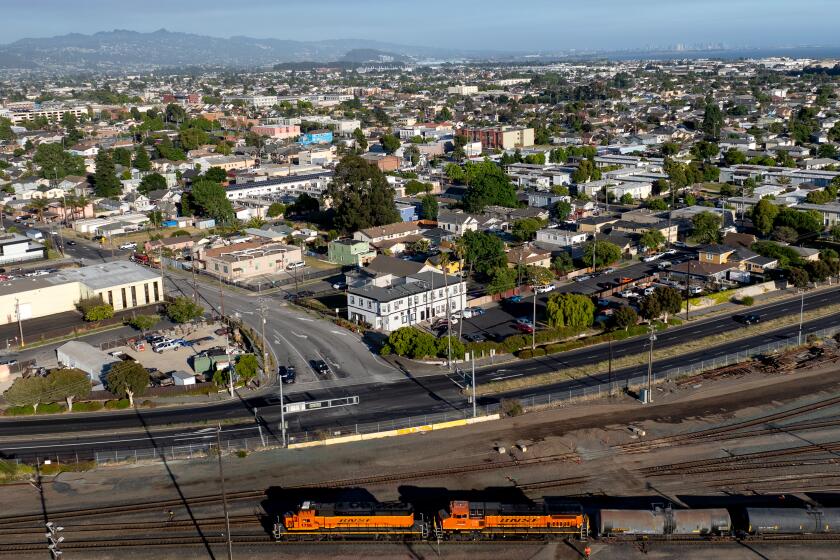First L.A. Newspaper Took Up the Rebels as a Cause
Sutter’s gold brought Henry Hamilton to California in 1849, and the black gold of printer’s ink lured him to Los Angeles.
Pro-slavery and hot-tempered, he became an outspoken critic of President Lincoln. He was a Southern sympathizer whose weapon of choice was the city’s first newspaper, the Los Angeles Star.
Armed with his printing press and a vision of a pure white society, Hamilton aimed to divide California into two states, one slave and one free.
During the Civil War, the weekly Star’s biting attacks on Lincoln got Hamilton and a cohort sent to Alcatraz for sedition, according to author and local historian John W. Robinson.
The four-page Los Angeles Star -- two pages in English and two in Spanish, also called La Estrella -- debuted May 17, 1851. One of its founders was William H. Rand, a mapmaker who left to start Rand McNally Co.
In its first issue, the Star reported that Los Angeles County had 8,329 residents, including “Indians and foreigners.” Good whiskey was 50 cents a quart, and hangings were a community sport. The city hadn’t changed much when Hamilton bought the paper five years later.
A native of Ireland, Hamilton immigrated to the United States in 1848, when he was in his 20s. He worked as a printer and reporter in New Orleans.
Gold drew him to San Francisco with the other 49ers. After a short fling at mining, he landed a job as a reporter.
“Only the barest facts about Hamilton’s background are known,” said Robinson, who wrote about him in the 1997 Dogtown Territorial Quarterly, a historical journal now known as the California Territorial Quarterly.
In 1851, when the San Francisco paper folded, Hamilton and two other journalists founded the Calaveras Chronicle. He wrote about foreign and local politics -- until he realized that miners were more interested in mining than reading. He sold his share of the paper.
Slavery was polarizing the nation; already, some spoke of secession. Northern California was firmly loyal to the Union, so Hamilton headed to Southern California. The region, especially Los Angeles, was decidedly sympathetic to the South.
In 1856, Hamilton took over the foundering Star and turned it into a thriving paper that espoused Southern causes, including states’ rights, secession, tariffs and slavery. As a side job, he sold fire insurance.
Hamilton’s first issue was published Jan. 14, 1856, with 500 copies in English and 200 in Spanish. (A year earlier, the Star’s Spanish-language printer-editor had started his own paper, El Clamor Publico.)
Within days, Hamilton’s paper had a scoop: A young woman who had been assumed dead had been seen. Five years earlier, Olive Oatman, then 13, and her family had been attacked by Yavapai Indians as they crossed the Arizona desert. Everyone assumed that Olive had been killed, but instead she had been sold to the Mojave tribe.
The story brought about her rescue. Then, in the Star, she described her life among Indians who treated her kindly -- an unimaginable concept in the frontier West.
Racial tension in Los Angeles was increasing in 1856. Vigilante committees often lynched Mexican gunslingers but freed white ones or allowed them to escape justice through transparent legal maneuvers.
But the catalyst that brought the city’s Mexican population to a near-boiling point was the case of William Jenkins, a deputy marshal charged with killing a family man named Antonio Ruiz. The deputy shot Ruiz while trying to repossess a guitar that Ruiz claimed was a family heirloom. The Star barely gave a nod to the shooting, trial and 15-minute jury deliberation leading to acquittal.
In the meantime, El Clamor Publico -- The Public Outcry -- chronicled Mexican fury in meticulous detail.
The next year, in 1857, Hamilton devoted his entire four-page paper to the murder of Sheriff James Barton and three deputies, who had been ambushed and killed by Juan Flores and his gang of outlaws. Hamilton advocated vigilante justice.
Angelenos took his idea to heart, and Hamilton recoiled. “When the citizens of Los Angeles lynched [Flores gang member] Pancho Daniel for asserted complicity in the murder of Sheriff Barton,” William Rice wrote in his 1947 book, “The Los Angeles Star,” Hamilton condemned the act -- even though he believed Daniel to be guilty.
Hamilton’s foremost passion remained politics, especially as the Civil War approached. The slavery issue had already divided the nation and split the long-dominant Democratic Party into Northern and Southern factions.
Hamilton’s allies included Edward John Cage Kewen, a hot-tempered Southern lawyer and orator who had been California’s first attorney general. Kewen moved to Los Angeles in 1858, opened a law practice and served as district attorney from 1859 to 1861. He also wrote for the Star.
“Hamilton and Kewen were bookends that closed an era of Southern California’s relative isolation,” Ronald C. Woolsey wrote in his 1996 book, “Migrants West: Toward the Southern California Frontier.”
In 1859, Hamilton was honored at a Democratic barbecue in El Monte. Kewen addressed the crowd for two hours, lambasting abolitionist Democrats. In particular, he singled out a leading citizen, rancher John Warner, whom he called a “hoary miscreant, covered with crimes like Lazarus with sores.” Kewen received a tremendous ovation.
In 1860, Kewen spent almost as much time fighting his own legal battles as he did representing clients. He threatened to kill a prosecutor in court, Hamilton reported: First, he hurled a pitcher, a glass and an inkstand, then he drew a derringer. As he cocked it, bystanders grabbed his arm, “but in the struggle the pistol was discharged, the ball lodging in the leg of an unfortunate Mexican.”
During the 1860 presidential campaign, Hamilton vowed to help take California out of the Union if Lincoln won. When his firebrand editorials failed to sway the outcome, he tried to divide California.
“Week after week, Hamilton defended the Confederacy and hammered away at Lincoln,” Robinson wrote. He called the North-South clash “a holy war, waged in defense of the Constitution, states’ rights and, above all, white supremacy.”
Even as the Civil War raged, Hamilton and Kewen continued to disparage Lincoln and federal authority. Civic leaders accused them of treason and demanded that the Star be closed. On Feb. 14, 1862, Los Angeles’ leading newspaper was banned from the U.S. mail, Robinson wrote.
That October, federal troops arrested Kewen, newly elected to the state Assembly, for “cheering for Jeff Davis and other disloyal utterances,” the Star reported. Within a week, Hamilton also had been arrested for disloyalty.
Both were sent to the military prison on Alcatraz Island. There they stayed for a few weeks, until friends interceded, Robinson wrote. Hamilton and Kewen each posted $5,000 bail and signed an oath of allegiance to the federal government in exchange for freedom.
Kewen stayed in office until his term expired in 1864. He returned to Los Angeles and resumed practicing law.
Hamilton focused on his own political ambitions in 1863, using the Star to promote himself for the state Senate. He won.
As legislative responsibilities kept him in Sacramento, newspaper subscriptions fell. Hamilton filed for bankruptcy in 1864, the paper closed, and he lost his campaign for reelection.
After the war, he traveled the Southwest, dabbling in Arizona politics and later starting the Guardian newspaper in San Bernardino. In 1868, he returned to Los Angeles and revived the Star, guiding it back to solvency.
Hamilton, the paper’s longest-serving editor, sold the paper in 1873; it ceased publication in 1879. Other papers had been founded in the meantime, including the Evening Express in 1871 and the Evening Herald in 1873. The Times began publishing in 1881.
Hamilton retired to a 10-acre San Gabriel citrus ranch, where he enjoyed modest success and served as justice of the peace. He died of asthma in 1891.
“Having faded from public view,” Robinson wrote, “his obituary rated but two lines on Page 7 of the Los Angeles Times.”
More to Read
Sign up for Essential California
The most important California stories and recommendations in your inbox every morning.
You may occasionally receive promotional content from the Los Angeles Times.






